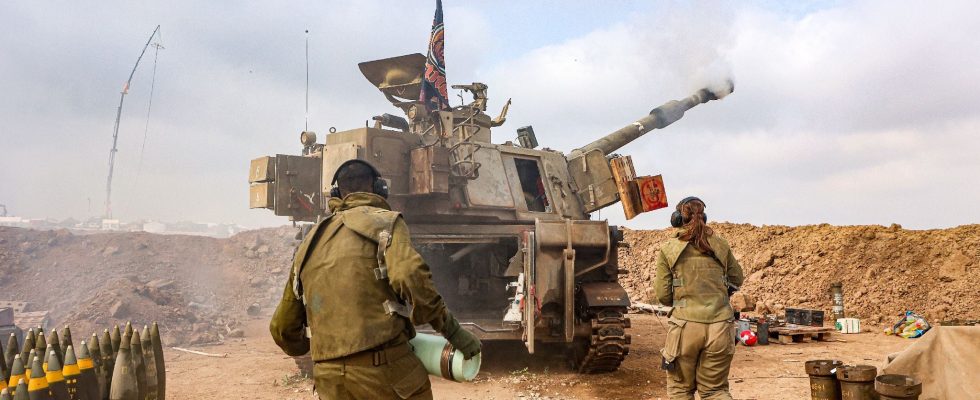It is a strip of sand 1 kilometer wide by a dozen long, where houses, market garden plantations, dunes and vacant lots follow one another. And, from now on, makeshift tents and populations in distress. The coastal commune of Al-Mawasi, in the southwest of the Gaza Strip, has been designated by the Israeli authorities as the “humanitarian zone” where Palestinians can find safety from the fighting and benefit from support from NGOs – support that is still not in place. In the coming days, this thin coastal zone described as “unsuitable”“without facilities” and already “overcrowded” could see even more people surge.
Because, barely a few days after the end of a truce that lasted seven, the Israeli army decided to carry out a ground operation in the southern part of the Gaza Strip, similar to what she has already done so in the northern part. Its designated objective: Khan Younes, a town on the outskirts of which camps for displaced people are located and where Yahya Sinouar, the architect of the surprise attack of October 7 and the massacre of more than 1,200 Israelis, is believed to be located. The leader of Hamas in Gaza was born there and lived much of his life there, with the exception of twenty-two years spent in prison in Israel – he was released in 2011, along with nearly 1,000 other prisoners in exchange of soldier Gilad Shalit.
“There are two reasons why the Israeli armed forces target Sinwar, considered a tough guy: first, his role in the October 7 attack, which means that he has become more than a symbol, a myth to take down to deal a blow to the chain of command and the motivation of the fighters, says Michael Milshtein, director of the Forum for Palestinian Studies at Tel Aviv University. Then, it is possible that Hamas demonstrates more flexibility regarding the Israeli hostages, if Sinwar is killed. I can’t imagine him surrendering to be tried in court.”
Khan Younes is also the birthplace of Mohammed Deïf, who heads the military wing of Hamas, also among Israel’s priority targets. Several Hamas battalions are believed to be positioned in the city, where massive bombings have been carried out in recent days, preceded by calls for the population to evacuate certain areas. “The Israeli army wants to destroy as many fighters as possible, a certain number of whom were able to move from the north to the south of Gaza with the truce, and intends to strike quickly and hard, especially since it was Hamas which broken the truce”, underlines General Jérôme Pellistrandi, editor-in-chief of the National Defense Magazine.
So here is the Israeli army engaged on two fronts at the same time. In the north, fighting continues, particularly in Gaza City and at the Jabaliya camp. “Around ten commanders have been eliminated and Hamas is less solid than the Israeli forces thought, applying above all guerrilla techniques,” notes David Khalfa, co-director of the North Africa Observatory and of the Middle East of the Jean-Jaurès Foundation. But this is not enough to trigger strategic success, because most of the command is in the South, where the situation could be even more complicated, with a diplomatic clock ticking more quickly.”
France, through President Emmanuel Macron, called for a ceasefire. This is not the case at the White House, where it was explained that the Israelis were “making efforts” to minimize civilian casualties. “I think that the American administration will continue to support Israel in its objective of destroying Hamas, unless a disaster occurs and it blames it, argues Michael Milshtein. The more flexibility Israel demonstrates in favor of humanitarian aid to Gaza and the more time it will gain for its military maneuvers against the Americans.”
These are nevertheless becoming more and more pressing in the face of very critical public opinion regarding the treatment of civilian populations in Gaza, even though Hamas uses them as shields. US Secretary of State Antony Blinken called for “avoiding damage to vital infrastructure” and demanded that the post-Hamas issue be taken into account. “Within the war cabinet, figures like Gadi Eisenkot and Benny Gantz [deux anciens chefs d’état-major] are pushing to respond to the United States’ demands, especially since Israel needs their military aid, their diplomatic capital and their veto in the UN Security Council”, specifies David Khalfa.
The number of civilian casualties continues to rise. “The things I saw are beyond anything that can be described,” said the president of the International Committee of the Red Cross (ICRC), Mirjana Spoljaric, after her visit to Gaza. shocked, these are the children who have horrendous injuries and who have also lost their parents and have no one to take care of them.” The Israeli army, for its part, demanded that the ICRC be able to have access to the 138 hostages still held in Gaza – 105 were released at the end of November.
How many deaths has the conflict caused in Gaza? The Hamas Health Ministry claims that more than 16,000 people have already been killed, 70% of them women and minors. The Israeli army claims, for its part, that its intervention in Gaza in recent months has left two civilians dead for every one combatant. Beyond these estimates, an entire territory will be devastated for a long time. The UN estimates that more than half of Gaza’s homes are destroyed or damaged and that 1.9 million people, or 85% of Gaza’s population, have been displaced. It seems illusory to believe that they will all be able to find refuge in the coming days in Al-Mawasi.
.
